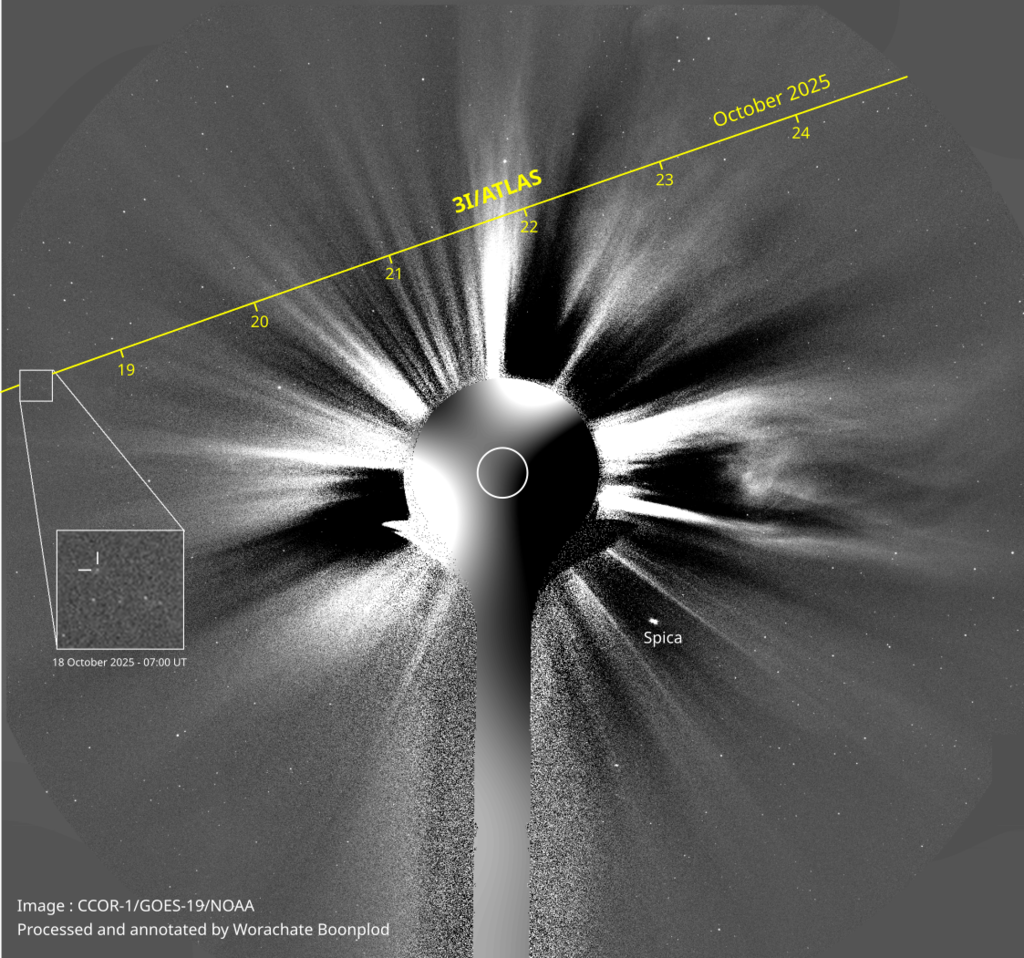NASA spacecraft reveal interstellar comet 3I/ATLAS brightened rapidly as it swooped behind the sun
Interstellar comet 3I/ATLAS is briefly out of view as it travels around the sun this week, but researchers and amateur astronomers used spacecraft data to track its progress right up until perihelion.

Comet 3I/ATLAS is rapidly brightening as it swings behind the sun, spacecraft observations have revealed.
The comet has been flying around the sun, obscuring it from Earth’s view, to reach perihelion (its closest point to our star) on Thursday (Oct. 29).
Yet, while most of the world has been waiting for it to re-emerge, some researchers and amateur astronomers have been using spacecraft to follow its path.
On Oct. 18, amateur astronomer and seasoned comet hunter Worachate Boonplod spotted the comet in images from the National Oceanic and Atmospheric Administration's GOES-19 weather satellite, which uses an instrument called CCOR-1 to observe the sun as part of its regular space weather monitoring. Boonplod noted that comet 3I/ATLAS was easily detectable and was set to remain visible to the spacecraft until Oct. 24.
"Its brightness is comparable to nearby stars with magnitude ~11," Boonplod wrote on the Comets Mailing List group, part of the group email service Groups.io. (In astronomy, a higher magnitude corresponds to a brighter object; typically, objects with a magnitude greater than 6 are too faint for the naked eye to see.) "The comet is moving from left to right (relative to both the field and background stars) and should go out of the CCOR-1 field on October 24."
The GOES-19 satellite wasn't the only satellite with comet 3I/ATLAS in its sights. Also tracking it are NASA's Polarimeter to Unify the Corona Heliosphere (PUNCH) mission, which includes four small satellites aimed at the sun, as well as NASA and the European Space Agency's Solar and Heliospheric Observatory (SOHO), Universe Today reported. SOHO orbits the sun at almost 1 million miles (1.5 million kilometers) from Earth, with its Large Angle and Spectrometric Coronagraph (LASCO C3) instrument keeping track of comet 3I/ATLAS until Oct. 26. Coronagraphs, like those used by SOHO and GOES-19, are instruments that intentionally block the sun in images in order to study the surrounding atmosphere, or corona.
On Wednesday (Oct. 28), two researchers posted a study to the preprint server arXiv that reported comet 3I/ATLAS underwent rapid brightening ahead of perihelion. The team estimates that, at perihelion, the comet will have brightened to roughly magnitude 9 — still too faint to be seen with the unaided eye, but bright enough to be seen by good backyard telescopes, if it were visible from Earth.
Get the world’s most fascinating discoveries delivered straight to your inbox.
The study relied on space-based solar instruments like GOES-19 and SOHO, and found that the comet was distinctly bluer than the sun, which was consistent with gas emissions contributing substantially to the comet’s increased brightness near perihelion, according to the study's authors. This is expected of comets, which heat up as they approach the sun, causing surface ices to sublimate into gases that wrap around the comet’s body and contribute to its tail. Solar radiation ionizes the gas, causing further brightening.
Scientists have been using various telescopes to learn all they can about comet 3I/ATLAS since its discovery in July. The comet is only the third interstellar comet ever recorded, and findings thus far indicate that it's zooming through our solar system at speeds in excess of 130,000 mph (210,000 km/h) in an unusually flat and straight trajectory.
Despite some rather frenzied speculation that comet 3I/ATLAS could be an alien spacecraft, most astronomers are confident that this interstellar visitor is a space rock from an unknown star system far away.
The speed of the comet, which has the highest velocity ever recorded for a solar system object, suggests that it has been traveling for billions of years, gaining momentum from a gravitational slingshot effect as it whips by stars and nebulas, according to a NASA statement .
In fact, 3I/ATLAS could be the oldest comet ever seen, with one study suggesting it's around 3 billion years older than our 4.6 billion-year-old solar system. The comet is also likely the largest interstellar object ever seen, though researchers are still pinning down its exact size. Hubble Space Telescope data suggest that 3I/ATLAS has a maximum width of about 3.5 miles (5.6 km).
The comet will become visible again to Earth-based telescopes by early December, according to NASA, and may even be visible to spacecraft orbiting Jupiter as it makes a close approach to the gas giant in March, 2026.

Patrick Pester is the trending news writer at Live Science. His work has appeared on other science websites, such as BBC Science Focus and Scientific American. Patrick retrained as a journalist after spending his early career working in zoos and wildlife conservation. He was awarded the Master's Excellence Scholarship to study at Cardiff University where he completed a master's degree in international journalism. He also has a second master's degree in biodiversity, evolution and conservation in action from Middlesex University London. When he isn't writing news, Patrick investigates the sale of human remains.
You must confirm your public display name before commenting
Please logout and then login again, you will then be prompted to enter your display name.


